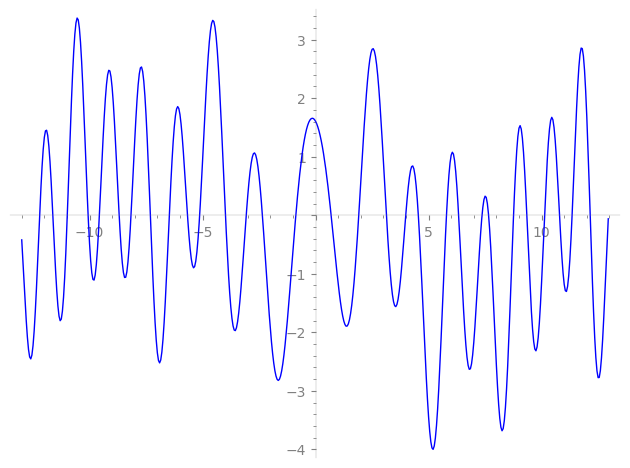| L(s) = 1 | − 0.340·5-s + (−1.09 + 2.40i)7-s − 0.671·11-s + (1.62 − 2.81i)13-s + (1.10 − 1.90i)17-s + (−0.242 − 0.419i)19-s + 4.18·23-s − 4.88·25-s + (−0.478 − 0.829i)29-s + (1.04 + 1.80i)31-s + (0.373 − 0.818i)35-s + (4.81 + 8.34i)37-s + (3.90 − 6.75i)41-s + (3.66 + 6.34i)43-s + (1.34 − 2.33i)47-s + ⋯ |
| L(s) = 1 | − 0.152·5-s + (−0.414 + 0.909i)7-s − 0.202·11-s + (0.450 − 0.779i)13-s + (0.266 − 0.462i)17-s + (−0.0555 − 0.0961i)19-s + 0.873·23-s − 0.976·25-s + (−0.0889 − 0.154i)29-s + (0.187 + 0.323i)31-s + (0.0631 − 0.138i)35-s + (0.791 + 1.37i)37-s + (0.609 − 1.05i)41-s + (0.558 + 0.967i)43-s + (0.196 − 0.340i)47-s + ⋯ |
\[\begin{aligned}\Lambda(s)=\mathstrut & 3024 ^{s/2} \, \Gamma_{\C}(s) \, L(s)\cr =\mathstrut & (0.857 - 0.514i)\, \overline{\Lambda}(2-s) \end{aligned}\]
\[\begin{aligned}\Lambda(s)=\mathstrut & 3024 ^{s/2} \, \Gamma_{\C}(s+1/2) \, L(s)\cr =\mathstrut & (0.857 - 0.514i)\, \overline{\Lambda}(1-s) \end{aligned}\]
Particular Values
| \(L(1)\) |
\(\approx\) |
\(1.604748804\) |
| \(L(\frac12)\) |
\(\approx\) |
\(1.604748804\) |
| \(L(\frac{3}{2})\) |
|
not available |
| \(L(1)\) |
|
not available |
\(L(s) = \displaystyle \prod_{p} F_p(p^{-s})^{-1} \)
| $p$ | $F_p(T)$ |
|---|
| bad | 2 | \( 1 \) |
| 3 | \( 1 \) |
| 7 | \( 1 + (1.09 - 2.40i)T \) |
| good | 5 | \( 1 + 0.340T + 5T^{2} \) |
| 11 | \( 1 + 0.671T + 11T^{2} \) |
| 13 | \( 1 + (-1.62 + 2.81i)T + (-6.5 - 11.2i)T^{2} \) |
| 17 | \( 1 + (-1.10 + 1.90i)T + (-8.5 - 14.7i)T^{2} \) |
| 19 | \( 1 + (0.242 + 0.419i)T + (-9.5 + 16.4i)T^{2} \) |
| 23 | \( 1 - 4.18T + 23T^{2} \) |
| 29 | \( 1 + (0.478 + 0.829i)T + (-14.5 + 25.1i)T^{2} \) |
| 31 | \( 1 + (-1.04 - 1.80i)T + (-15.5 + 26.8i)T^{2} \) |
| 37 | \( 1 + (-4.81 - 8.34i)T + (-18.5 + 32.0i)T^{2} \) |
| 41 | \( 1 + (-3.90 + 6.75i)T + (-20.5 - 35.5i)T^{2} \) |
| 43 | \( 1 + (-3.66 - 6.34i)T + (-21.5 + 37.2i)T^{2} \) |
| 47 | \( 1 + (-1.34 + 2.33i)T + (-23.5 - 40.7i)T^{2} \) |
| 53 | \( 1 + (-6.12 + 10.6i)T + (-26.5 - 45.8i)T^{2} \) |
| 59 | \( 1 + (-2.47 - 4.28i)T + (-29.5 + 51.0i)T^{2} \) |
| 61 | \( 1 + (-1.76 + 3.04i)T + (-30.5 - 52.8i)T^{2} \) |
| 67 | \( 1 + (-6.16 - 10.6i)T + (-33.5 + 58.0i)T^{2} \) |
| 71 | \( 1 + 5.57T + 71T^{2} \) |
| 73 | \( 1 + (3.71 - 6.43i)T + (-36.5 - 63.2i)T^{2} \) |
| 79 | \( 1 + (5.00 - 8.67i)T + (-39.5 - 68.4i)T^{2} \) |
| 83 | \( 1 + (-2.47 - 4.28i)T + (-41.5 + 71.8i)T^{2} \) |
| 89 | \( 1 + (-8.52 - 14.7i)T + (-44.5 + 77.0i)T^{2} \) |
| 97 | \( 1 + (-4.23 - 7.33i)T + (-48.5 + 84.0i)T^{2} \) |
| show more | |
| show less | |
\(L(s) = \displaystyle\prod_p \ \prod_{j=1}^{2} (1 - \alpha_{j,p}\, p^{-s})^{-1}\)
Imaginary part of the first few zeros on the critical line
−8.689170928575039110909631689941, −8.164929443483337686604825375387, −7.30932194741589997582608629058, −6.47042154075259325737161974005, −5.66659557594720229279246514885, −5.12860643016693840596888256005, −3.98588735258881813358056214902, −3.06718889847588011362968265500, −2.35247238673767741059611807129, −0.873152080779529402500948921403,
0.68834399567838738419124204041, 1.91103153056812731115074669994, 3.13501201898629519613844074751, 3.99010275081120622945002402629, 4.54646335086879531754580342189, 5.79185947742186779714654599415, 6.32889349869405635535516677552, 7.36509713691863148664965308427, 7.65469813697669187722729619557, 8.759287756383194078295354636658

